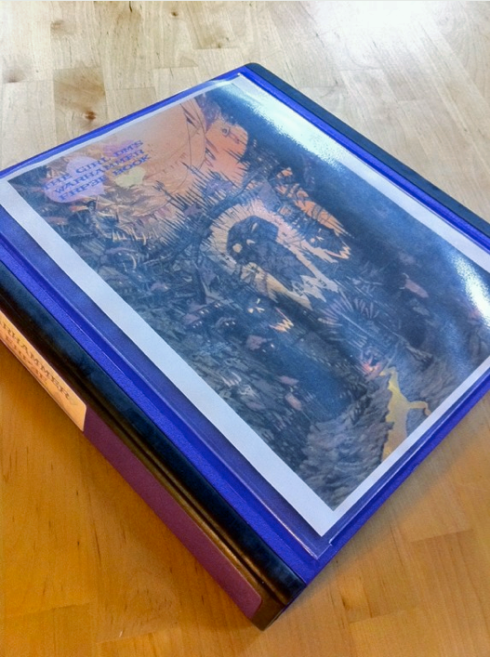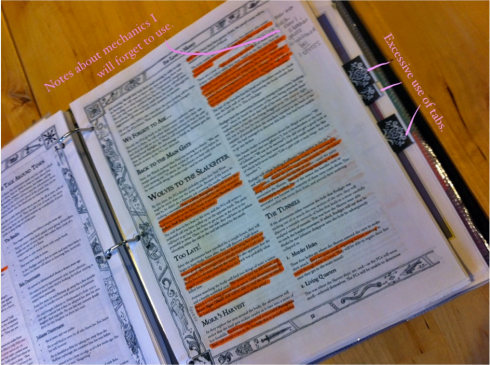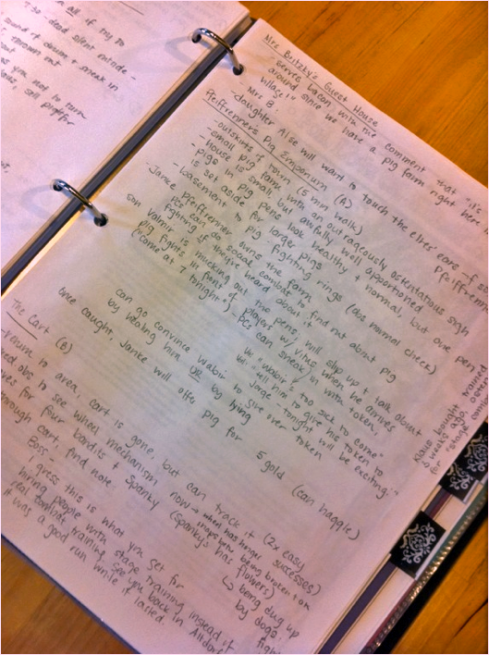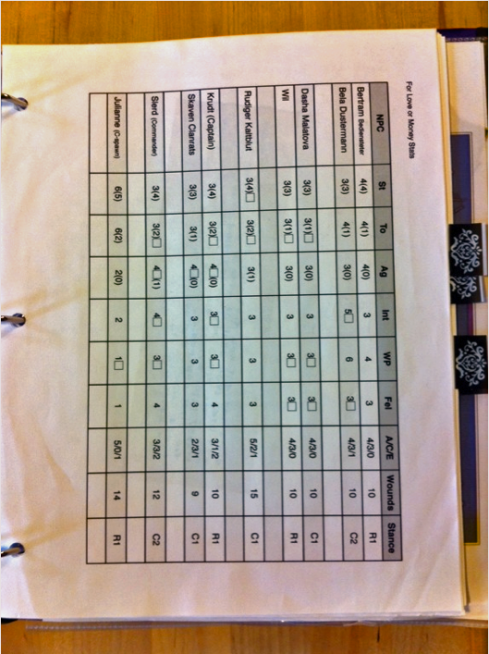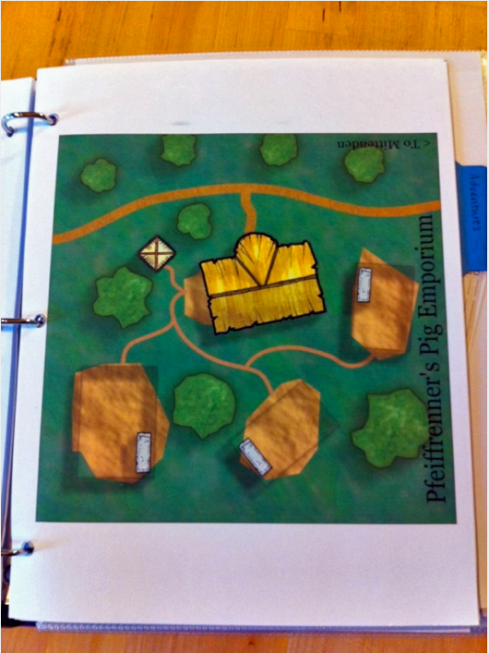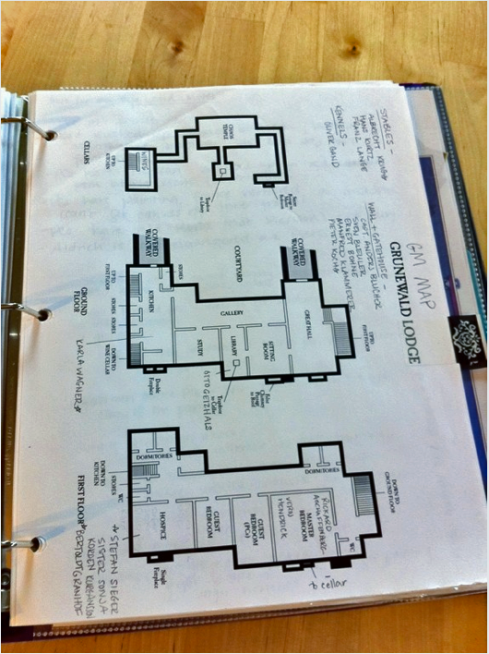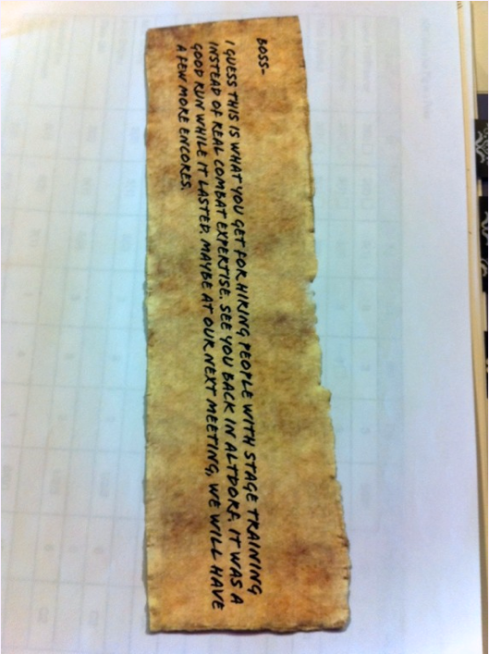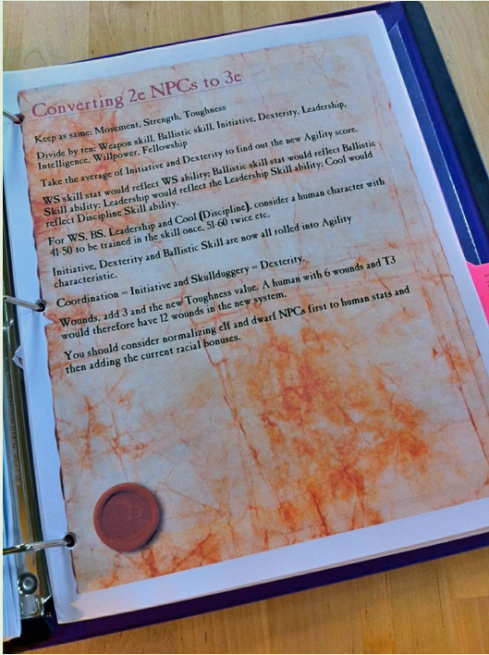You are currently browsing the tag archive for the ‘Mouse Guard RPG’ tag.
I’m really not sure how this hasn’t been done to death yet, but I’ve decided that it’s high time for me to do it–the hilarity factor of juxtaposing such differing worldviews is just way too high for me to give it a miss:
It’s going to be the second in my “Monsterz” series of one-off games in which my Warhammer players RP as various monster races. (The unclever name of the ‘series’ just comes from the title of the folder on my Mac where I’m keeping all of the files. I’m not sure what I was thinking when I added that jaunty z, because now it just seems rather stupid.) I did the monster PC thing back with the Orcs, and the players had a good time, although I had some difficulty balancing out my interest in fleshing out their premade PCs (which I did) with developing the adventure (which I didn’t nearly enough.) I plan to remedy that this go around.
So far, it’s been a blast coming up with skills and wises for Skaven. Frankly, I think the original game needs “Warpstone-wise,” don’t you?
Most of all, though, because I’m me, I’ve had a great time photoshopping (or Pixelmating) the existing Mouse Guard character sheets and writing character histories. Of course, I don’t have any Skaven minis lying around, which necessitates the most dangerous thing of all in our house…painting minis. God help us all.
With the way work has been going, we can expect this little iteration to be finished sometime around November 2043. Or in a couple of weeks, if I stay this interested.
In the meantime, just remember:
It’s not what you fight for, it’s how many of those other mangy curs you can claw to bits on your way down!

Just a tiny post tonight because I have a long presentation to give at work tomorrow (Four hours! Whee!) and am getting ready for Mepacon this weekend. It’s not a convention we’ve been to before, but we have a handful of friends going, so even if it’s not perfect, we’ll be able to play board games ourselves. Besides, we tend to get nervous if we go too many months without attending a gaming convention, and I had to miss Metatopia last weekend due to work.
I’m planning on taking my Mouse Guard Box Set and running a game for my friends; I toyed with the idea of officially GMing a session there, but I knew work was likely to be hellish this month, and I didn’t want to obligate myself to prepping a convention scenario and setting up for teaching rules to possibly nitpicky strangers. Ultimately, I’m glad I didn’t. It’s kept me down to three nervous breakdowns this week instead of the usual 5.8/week that I usually have this time of year.
All that being said, I’m going to spend some time tonight putting together some player kits and aids like I did the last time I ran MG, although I may make an even more robust set of player aids. That way, if I feel like running MG for complete strangers, I’ll have what I need.
Anyway, I hope you all have a wonderful weekend. I’m off to fret over the most efficient way to pack my RPG stuff, which will allow me to avoid fretting over the presentation I have to give tomorrow. There’s more than one reason they call our hobby ‘escapism!’
Today I’m going to do a post about visual depictions of women in the RPG hobby. If you just want to go to my usual ramblings about my rampant consumerism, skip to the next post.
Although I often find myself advocating for the rights of other women at work and in my hobbies, I don’t often consciously think of myself as a feminist. Perhaps that’s because I don’t have much in common with women when they tend to be doing the things that women do when they get together. I don’t like to shop for clothes, go to the spa, or receive chocolates/flowers/ diamonds. Even the most fleeting thought of becoming a mommy makes me nauseous. Engaging with ‘adorable’ small children bores me to tears. I don’t find the majority of television, films, or books targeted towards women interesting. Not surprisingly, I find the vast majority of blogs about the female experience profoundly alienating, because while most feminists argue that we shouldn’t stereotype women, many feminist bloggers use those same stereotypes to engage with a of “sisterhood” of readers whose preferences exclude me.
Not too long ago when someone on my Twitter feed pointed to a post on Wundergeek’s blog, Go Make Me a Sandwich, I was surprised to find myself entirely engaged by her arguments. The post in question was about Shelly Mazzanoble, whose writing I generally find abhorrent because she glorifies a type of anti-intellectual, attention-seeking gamer that I wouldn’t want in my game regardless of his/her gender. After I finished Wundergeek’s spot-on critique of Mazzanoble, I sat for a few hours reading Wundergeek’s previous entries. She catalogs and critiques the implicit sexism in the video game and board game industries with wit and nuance. She’s dedicated much of her blog to making us see what’s right in front of our eyes. We see so many distorted and sexualized images of the female body in our hobby that they start to look normal after awhile, even to a woman like me who not only knows that her own body doesn’t look like those images, but who also does quite a bit of media studies scholarship during her daily life. When I started reading Wundergeek’s blog, I didn’t think I was as bothered by most of the sexist imagery she was seeing as she was…and that rather bothered me.
Back in my teens and early twenties when I used to play D&D because it was the only thing widely available, I used to joke about wanting to see “a few female miniatures with their clothes on.” Generally speaking, miniature companies have accommodated me a bit more each year; it’s easier and easier to find women who aren’t in fur bikinis on the rack at my FLGS with each passing season, although boobs do still tend to be these tiny figures’ main feature. Overall, though, I wouldn’t have said that the body images of the women in RPGs mattered to me that much. Then I started thinking about the four games I find the most engaging.
Warhammer 3e, Fantasy Flight Games
As most of you know, I’ve GMed Warhammer FRP 3e for the past year or so, and I’ve spent quite a bit of time contributing to its fan communities in various ways. I’ve found the people there engaging, friendly, scholarly, and not willing to take much BS (all traits I appreciate.) You won’t find many vocal women in the WFRP fan community because it’s not a community that prizes sharing one’s personal history; they may be there, but I’m not sure I’d know it. On the company side, WFRP does have a female art director, Zoe Robinson. Perhaps it’s not surprising, then, that iconographically, WFRP is one of the best mainstream RPGs on the market for varied and non-sexualized images of women. A good chunk of the career cards (the depictions of WFRP’s equivalent of “classes”) include pictures of women, and the women are surprisingly fully clad, dressed in clothing that makes sense for their particular lot in life. Best of all, they’ve been posed in ways that represent their personalities and attitudes, not in ways calculated to show off their T&A. Check out some of these depictions from the Core Set:

Even the images that do show more skin seem to do so for the sake of emphasizing grace and athleticism rather than overt sexuality; this woman’s legs, arms, and midriff seem on display to show her agility rather than to highlight her boobs:

Fortune’s Fool, Pantheon Press
Classical paintings or modifications of classical paintings grace many of the pages of Fortune’s Fool, but the company does produce some of its own art. Take a look at this image, in which the woman’s clothing and body language underscore her regal authority:

Although this rulebook makes a distinction between the stats for men and women, both genders get a different kind of bonus, and the fact that the designers saw fit to talk about those differences seems welcoming rather than punitive.
Burning Wheel, Luke Crane
I adore the BW system because it manages to be simultaneously more gamist and narrativist than most other games I play. (That alone may suggest the flawed nature of those distinctions, but I generally find them helpful when talking about the kind of games I like, which tend towards the narrativist.) BW’s open system allows the GM to create his own world, so perhaps the rulebook is automatically less likely to put women in one box or the other–it leaves that task up to the GM. Still, BW’s graphics go out of their way to feature sensibly clad, non-sexualized women whose clothing and gestures that emphasize their personalities and jobs, like this one:

Mouse Guard, Archaia Entertainment
Okay, so you may laugh at me about this one, but I have to mention it. David Petersen, the creator of the Mouse Guard comic, has made sure to include lots of positive female role mice, including Gwendolyn, who runs the Guard wisely and garners the respect of mice from throughout the land, so the RPG begins with an advantage because of its inclusive setting. In the early pages of the rulebook for the RPG, Crane points out that he’s going to use the masculine pronoun for continuity throughout the text, but makes sure to remark that there “are just as many girl players as boy players of Mouse Guard,” and discusses his reasons for choosing the male pronoun, partly because “the main character of the series, Lieam, is a boy mouse” (Crane 14). The author both considers his pronouns carefully and walks his reader through his reasoning for choosing the pronoun; most RPG books are seldom so overtly welcoming to female players!
The mice in the images in this game have no clothes on and yet manage to be less sexualized than the partly clad women in most RPGs! Okay, yes, that’s a little silly, but first, check out the heroic pose of Sadie, one of the Guard Mice included in the Sample Mission section of the text:

She stands in a heroic and commanding pose, ready for action with her sling and double-dagger belt. Only her pink cloak gives her away as a girl at all.
You may argue that the whole point is silly–how could you sexualize mice in the first place? Well, there are certainly anthropomorphized animals in games that go out of their way to emphasize the sexual parts of the female form; think about the ridiculous boobs and narrow waist of a WoW Tauren, for instance. Yet you don’t even have to morph the body to make the depiction problematic. Take a look at this image of Minnie Mouse:
Here, Minnie poses in a traditional pinup girl pose, exposing her leg and rounding her rump for the viewer, while wearing a bow and high heels to mark her femininity. Absurd as it is, this is a sexualized image of a freaking female mouse–a mouse that you may have around your home as a role model for your children. Parents of children, please go gather up all the Disney junk you have lying around, put it in a box, use it as fire starters this winter, and replace it with Mouse Guard comics. Petersen’s guardmice are much better role models.
To sum up, I think that for all the frustration that women might feel about the hobby, there are a handful of dedicated, thoughtful writers and publishers who actively seek to include women in their games. Every time a game makes a series of inclusive gestures, it takes a step towards normalizing those gestures within the hobby. Perhaps one day, we’ll play in a hobby where we find it odd if there aren’t as many images of women as men on the pages of our rulebooks. Better yet, we might play in a hobby one day where men and women both laugh openly at a publisher who chooses to include an overwhelming number of improbably sexualized images of women. Until then, though, what we can do is support those publishers who choose to depict a range of powerful and interesting female characters and buy miniatures whose boobs, midriffs, and legs won’t freeze off during the winter from overexposure.

It’s always nice to get a surprise gift from your spouse. I have read on the Internet that some women like flowers or chocolate, but I prefer gaming stuff. (Big surprise.) Last week, I got surprised with a Fantasy Flight Supply Dice Bag. I’d had my eye on these on the website, but couldn’t really justify buying one because I don’t have many un-bagged dice lying about. But, hey, a present! You can’t say no to a present.
The bag is quite nice; it’s made of soft nylon with a suede-like exterior. Mine has the sword detail, printed in a sparkly silver metallic color. At 6.25×9″, the roomy bag easily holds far more than a full set of d20 or WFRP dice; you could probably sneak in a small pad and a little pencil, too, for travel gaming.

Mine’s currently holding the graphic Mouse Guard dice from the Boxed Set. Although I feel a bit guilty about putting non-FFG dice in an FFG bag because I’m crazy like that, the sword seems thematically appropriate for the little mice fighting for what they believe. Neither sword-wielding mouse nor FFG employee has come to my door yet to complain. Now that I think about it, though, it would be pretty cool if an armed mouse showed up at my house. If that happens, I’ll be sure to take pictures and post them.
I posted some ideas awhile back about traveling with RPG minis and scenery. Sometimes, though, you don’t quite need that much stuff. Either you’re going to a place with limited table space, or you’re taking an RPG which doesn’t require quite as much outlay. This weekend, I went to a little local gathering held mostly outdoors with my Mouse Guard stuff. Although I love my Box Set, I wasn’t willing to take the Set (in its pristine condition!) to play with a bunch of people I don’t know in the rather unpredictable Great Outdoors, so I grabbed my older MG rulebook and a few key items and stuck them into this awesome scrapbook case:

I love this thing because it’s made of very thick, durable plastic; it’ll keep out the rain and the dirt (or the spilled Coke, if you’re at an indoor con.) It’s large enough to hold pages bigger than 8.5×11″, and tall enough that you can stack a couple of books and some dice bags into it easily. And if you need to, you can use it as a place to roll your dice once you’ve taken out all the stuff inside. Plus, it’s cheap! Here, I brought my rulebook, my bag of dice, a bag of dice for my players, character/GM sheets in plastic sleeves, and a bag of pencils and wipe-off makers. (Since you repeatedly have to re-mark your combat actions on sheets in Mouse Guard, it’s easiest to take a wipe-off marker and pages in sleeves and just have the characters wipe away their choices between each combat turn. It’s cheap, compact, and easy, and keeps you from having to reprint combat sheets for each encounter or from ending up with sheets so often erased that they end up illegible.)
If you’re interested in picking up a case, you can find one here.
Work ramps up today for the first time in several months, so I’m pleased to report that this will be the first blog post of the year drafted during a meeting! (I won’t get around to posting it during the meeting, but I will have started it then.)

Since acquiring the Mouse Guard Box Set, I’ve naturally put Mouse Guard on the table as a fall RPG option for my players. I now had an excuse to scoop up Reaper’s Mouslings Set, which I’ve been eyeing for a long time but had no reason to purchase. If you’ve just purchased the Set and are eager to play, you might want to know that the Mouslings seem to be in Reaper’s boneyard; it isn’t clear how much longer they’ll be on offer. On the other hand, MG is a fairly abstract game, so you certainly don’t need them to play. (In fact, I’m thinking of not using scenery at all. I know. It’s hard to believe I would ever write such a thing. Still, things change so fast in MG, and in the test game I ran, I found it so much more fun to go with what the players suggested than with what I had in mind that I don’t want to end up limiting my options with too much premade scenery.)

The Mouslings are a great set, and the tiny minis are delightfully detailed casts, although they represent quite a few ‘types’ of characters you’re not likely to play in the game. There aren’t Gandalf-like wizard mice in the Crane/Petersen game, for instance. Still, the Mouslings are a fun set to own, and they come in a handy carrying case with a handle, so you can…um..I don’t know. Carry them somewhere. Like on vacation. I can’t tell you the number of times I’ve been in a foreign country and had a sudden and desperate need for a variety of anthropomorphic mice miniatures. It’s been at least…hmm…no times. But if it does come, I’ll be set, and let’s face it–peace of mind is invaluable.
This seems to be the week to freak out about the awesomeness of the Mouse Guard Box Set, and it is awesome, so I don’t want to be late in my freaking out about it lest I seem either unenthusiastic or unfashionable. In fact, I’ll go so far as to admit that I drove five hours to pick up my set when one of my players found out that it was available at a not-so-local friendly gaming store. It was worth it. (Thanks to DH for giving me the heads-up the second this came into view!)
I played the Mouse Guard RPG a little over a year ago at a convention and loved it immediately. Seldom had I seen a convention game with premade characters pull such thoughtful and deep roleplaying out of participants, and I was impressed by how easy it was to use the rules in innovative ways without knowing the whole system well. I’d picked up the rulebook then, and I loved its lush illustrations and clear, welcoming, and intelligent instructions. Mouse Guard’s streamlined Burning Wheel rules have removed everything extraneous about the parent system and left GMs with the perfect toolkit for running adventures that feel as though they’re straight from the pages of Petersen’s comic. Given the comic’s “It matters not what you fight, but what you fight for” tagline and Burning Wheel’s “Fight for what you believe” motto, the two are a perfect thematic match for one another.
When I heard that there was going to be a Box Set, I was pleased, as you can imagine. Stuff for a game for a game I like? Really pretty stuff for a game I like?! Let’s do it! NOW!
One of the first things I noticed is that Crane and Petersen haven’t included a lot of extraneous stuff. There’s beautiful, well-made, useful stuff, and a bit of fun fluff, but not a whole overwhelming host of table-filling junk that you don’t really need. (And here, I’m looking at you, my beloved WFRP3e. You might have overdone it just the slightest shade of a notch on your stuff quotient.) For instance, the Mouse Guard Box Set comes with a bunch of cards, but instead of the overwhelming array of skill cards you get in WFRP, you have a set of condition cards that remind you of each condition’s effects, a set of weapon cards to remind you of how a particular weapon changes each scripted volley of a fight, and set of common action cards to play instead of scripting your volleys on paper. That’s it. Players won’t sit behind a towering stack of skill cards, and they won’t spend twenty minutes shuffling through their deck to find the right skill for the job.

Beautiful design marks everything about this set, from the shiny box to the illustrated individual cards. Rules on the card are easy to read and understand, and each one includes just the right amount of information. Instead of regular d6s, the themed dice in the set now include snakes, swords, and axes. Although there are only a handful of dice, the basic dice mechanic hasn’t changed, so players (or the GM) can continue to use their own d6s if there aren’t enough themed dice at the table.

Perhaps most charming are the “carved” mouse pawns that look like those that Gwendolyn uses to mark the Guard Patrols on her own map. You get five (red, blue, yellow, green, and purple) and a map of the Mouse Territories with your game. I swooned over these when I saw them in the MTV unboxing post, but that picture didn’t indicate the heft and size of the pawns. I thought they were the size of a regular RPG miniature, but one easily fills the palm of my hand:

Still, you haven’t really lived until you’ve placed them on your own map of the territories:

I particularly like the map/pawn addition; even though it doesn’t technically add much to the gameplay, it does visually represent the role of the GM (who plays Gwendolyn and assigns missions) as an integral part of the game.
One last thing about the set: the included sheets keep up the high production value and thoughtful design of the rest of the materials. The GM sheets let the GM record all the pertinent information about a whole host of NPCs on one handy page. The character sheets do what character sheets usually do, but in a much more stylish way than usual. Petersen even includes a delightful pencil sketch of a bare-bones mouse that you can “fill in” with visual details to represent your own character.
Although the theme of Mouse Guard may not appeal to everyone, the Mouse Guard RPG makes great use of the BW rules for an exciting and interesting gaming experience evocative of the comic. The Box Set enhances that play with visually appealing gaming aids that will streamline your session and will allow your players to focus on the story and its puzzles rather than on the system. I do hope that the publisher will issue extra sets of themed dice, because my players love to have their own sets of dice. We spend 15 minutes at the end of each session trying to figure out which dice belong to whom; it’s our exit ritual, and I’m hoping it can be preserved.
Now get out there, Guards, and ride a rabbit across the snow in search of a dangerous snake! (Although you’re going to have to get a whole heap of successes to do those things, you know.)







